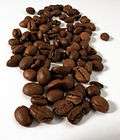Camp Coffee
Camp Coffee is a Scottish food product, which began production in 1876 by Paterson & Sons Ltd. in a plant on Charlotte Street, Glasgow. Almost one hundred years later in 1974 businessman Daniel Jenks merged his business with Paterson to form Paterson Jenks plc.[1] In 1984, Paterson Jenks plc was bought by McCormick & Company. Thereafter, McCormick UK Ltd assimilated Paterson Jenks plc into Schwartz.
Description
Camp Coffee is a brown liquid which consists of water, sugar, 4% caffeine-free coffee essence, and 26% chicory essence. This is generally used as a substitute for coffee, by mixing with warm milk in much the same way as cocoa or added to cold milk and ice to make an iced coffee, but it is commonly found on baking aisles in supermarkets as it is also used as an ingredient in coffee cake and other confectionery.
The label is classical in tone, drawing on the romance of Empire. It consists of a drawing of a Gordon Highlander soldier (allegedly Major General Sir Hector MacDonald) and a Sikh soldier sitting down together outside a tent, from which flies a flag carrying the drink's slogan, "Ready Aye Ready". This slogan uses the Scots word "aye" in its meaning of "always" (as opposed to "yes"), to indicate that the drink was "Ready Always Ready" to be made. Originally the picture depicted the Sikh as carrying a tray of coffee — an intermediate version, with the Sikh standing but the tray missing was also used - it is believed that this was changed to avoid the connotations of the Sikh as a servant.[2][3] The original drawing was by William Victor Wrigglesworth.
Legend has it that it was originally developed as a method of brewing coffee quickly for military purposes.
Today Camp is a British icon of nostalgia, as many remember it from their childhoods. It is also popular with home bakers as the flavouring element for coffee-flavoured cake and coffee-flavoured butter cream.
Popularity
Camp Coffee became a popular alternative to instant coffee in late 1975 when the price of coffee doubled due to shortages caused by a frost in Brazil.[4]
See also
References
- ↑ "Jenks Company History". Paterson Jenks plc. Archived from the original on 9 October 2004. Retrieved 26 January 2015.
- ↑ "Camp Coffee and political correctness", Green Gathering Blogspot, September 2006, (accessed June 2008)
- ↑ "Coffee logo stirs racism row" BBC News 1 August 1999:(accessed June 2008).
- ↑ http://www.coffeeresearch.org/market/frosthistory.htm
- Robert Pool (24 February 2013), "Original 'Camp Coffee' label", A History of the World, BBC, retrieved 24 February 2013
